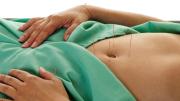Inflammation can both heal and harm. A core component of the immune system, it’s essential for recovering from an injury or infection—but too much can contribute to diabetes, heart disease, arthritis, cancer, and other serious illnesses.
“You need to fine-tune inflammation,” says professor of neurobiology Qiufu Ma, of Harvard Medical School and Dana-Farber Cancer Institute. He and a team of HMS neuroscientists, joined by collaborators in Houston and China, recently demonstrated one way to do that—with acupuncture.
During animal experiments, the researchers found that acupuncture activates different nerve pathways that can either suppress or promote inflammation, depending on where, when, and how it is used. Their work revealed that acupuncture stimulation can reduce systemic inflammation in mice experiencing cytokine storm, an extreme immune response in which the body rapidly releases excess inflammatory proteins. (Such dangerous and sometimes deadly inflammation is a hallmark of sepsis and has been seen with COVID-19; see “Raw and Red Hot,” May-June 2019, page 46, for more about the role inflammation plays in myriad diseases.) But Ma’s team also discovered that acupuncture can worsen inflammation when administered at the wrong time, suggesting the ancient healing technique can be harmful if not practiced properly. These findings, described in the journal Neuron in August, hold promise for improving acupuncture’s safety and effectiveness and eventually may help treat patients with inflammatory diseases.
Acupuncture uses fine needles to stimulate points on the body’s surface that scientists believe send nerve and biochemical signals to corresponding organs and systems. Traditional Chinese medicine describes this process as enhancing the flow of energy (qi) through invisible meridian channels to improve health. The practice is used worldwide to help relieve pain, depression, nausea, digestive problems, and other ailments and has been integrated into some parts of Western medicine. But exactly how it influences the nervous system, Ma says, is still unclear.
Building on research conducted elsewhere in recent decades, Ma’s lab—in its first foray into acupuncture research—wanted to clarify which nerve pathways are activated by acupuncture, and how that process helps tame systemic inflammation. The Harvard team applied “electroacupuncture,” in which mild electric current passes between two acupuncture needles, to mice with rampant inflammation from a bacteria-induced infection. They focused on the effects of this stimulation on two types of nerve cells, chromaffin cells and noradrenergic neurons, which together secrete the hormones adrenaline, noradrenaline, and dopamine, believed to play a role in the body’s inflammation response. Using a genetic tool to “knock out” these nerve cells, they confirmed that chromaffin cells and noradrenergic neurons are key regulators of inflammation.
Three factors—timing of treatment, placement of the acupuncture needles, and intensity of the stimulation—the investigators found, can produce markedly different outcomes in modulating inflammation.
In one experiment, they delivered high-intensity electroacupuncture to rodents’ abdomens and hind legs at different stages of infection. The stimulation excited noradrenergic nerve fibers in the spleen (a key immune system organ) that helped to either reduce or fuel inflammation, depending on when it was given. Mice treated preventively—right before their cytokine storm—developed less inflammation and fared much better than untreated mice; their survival rate improved from 20 percent to almost 80 percent. “But when the cytokine storm has already reached the peak, high-intensity acupuncture makes inflammation worse,” Ma warns. This finding may have important clinical implications, he notes, because patients often seek acupuncture therapy after they’ve already developed a health problem.
Location is also critical. The researchers gave low-intensity electroacupuncture to a point on the animals’ hind legs, driving a different nerve pathway called the vagal-adrenal axis that’s been shown to calm systemic inflammation. The approach caused chromaffin cells in the adrenal glands to secrete dopamine. After just 15 minutes of stimulation, those mice exhibited lower cytokine levels, which translated to a better survival rate (60 percent) than that for the untreated mice (20 percent). “It’s really remarkable,” Ma asserts of the results. This type of acupuncture treatment “reduced a whole range of cytokines simultaneously.”
Interestingly, the vagal-adrenal pathway could be excited only through the leg, not the abdomen. Ma says this indicates the body has an organized neural network that may elicit distinct biological changes when different regions are stimulated by acupuncture.
Another insight: for mice with cytokine storm, low-intensity stimulation was more reliable for quelling inflammation than its high-intensity counterpart, which can either suppress or worsen inflammation (as described above). “This suggests,” Ma says, “that for treating ongoing cytokine storm, low-intensity treatment to the hind-limb regions offers a safer route [than high intensity], and that the strength of the stimulation matters.”
For Ma, these collective findings signal that the 3,000-year-old practice of acupuncture—far from being folk medicine—has a scientific basis that could eventually be understood. That’s a puzzle he hopes to investigate further, through basic research in animals and work with clinical partners to examine how acupuncture treatments might help humans better “fine-tune” inflammation.









